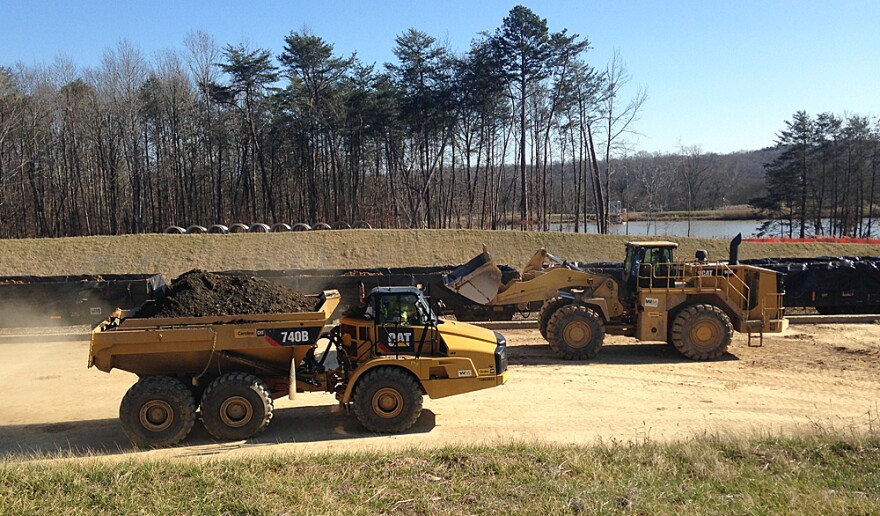Duke Energy is the largest electric utility in the country, with nearly $25 billion in annual operating revenue. And on a cold, blustery day at its Dan River site, that corporate power is on display.
Massive machines–40-ton trucks, front-end-loaders, and bulldozers–are moving in perfect synchronization, loading coal ash and soil into rail cars.
“This is priority one for Duke Energy right now,” says Jeff Brooks, a Duke Energy spokesman. “This is the most important thing that many of us have worked on for several years now. We have an army of engineers and technical staff that have developed the closure plans for these sites.”
On Super Bowl Sunday in 2014, a storm pipe underneath one of the coal ash basins broke, and nearly 40,000 tons of coal ash and 27 million gallons of contaminated water flowed through it and into the Dan River.
Since then, the General Assembly has passed one of the most aggressive coal ash cleanup laws in the country. But many of the plans detailed in the have stalled due to legal infighting and regulatory delays.
In some form, the excavation process happening here at Dan River will eventually happen at most of Duke Energy’s 14 coal ash facilities in the state.
An important step happened this past New Year’s Eve. That’s when the Department of Environmental Quality released a that rated each site by risk level. Dan River and three other sites are high risk, and must be excavated by 2019.
The remainder were rated intermediate or low - and are seeing significant permitting delays.
“Everybody’s trying to meet aggressive deadlines here,” says Brooks. “We’re all trying to do the best work that we can, and sometimes that gets bogged down in regulatory space, but our shared goal is to try to meet these goals together.”
The “regulatory space” surrounding coal ash only comes out into the open on occasion, and one of those happened last week at the General Assembly’s Environmental Review Commission.
Tom Reeder, an assistant secretary at the Department of Environmental Quality, gave an update to lawmakers.
And he was not shy about where the blame for the delays should be placed: the federal Environmental Protection Agency.
“For some reason, and I don’t know why, the EPA doesn’t seem to share our sense of urgency in pursuing these matters,” Reeder said, clearly agitated. “So we’re rethinking this whole thing. We may just take unilateral action without EPA anymore, because they just don’t seem to think this is important, for some reason.”
The EPA must sign off on permits granted by the state, and to Reeder’s dismay, he says that isn’t happening quickly enough. Reeder also blasted the media and the Southern Environmental Law Center for contributing to misinformation and delays. Lawmakers, most of them Republican, nodded in agreement.
Frank Holleman sat in the back of the room and listened carefully. He’s a senior attorney at the Southern Environmental Law Center, and he offered a different assessment.
“Duke Energy’s had a lot of problems,” said Holleman. “And of course they across the state and are now on criminal probation. But amazingly, as hard as it is to believe, they have been more willing to do cleanups and address issues than DEQ.”
An between Governor Pat McCrory and the General Assembly leadership – all Republicans - has halted the work of the that was created to oversee the coal-ash cleanup process.
Much of the current scientific concern is focused on two elements, hexavalent chromium and vanadium. They are both found naturally in soil. In high concentrations, like in coal ash, they are also carcinogens.
Reeder downplayed the threat to those who live near coal ash pits. In his presentation to legislators, he reached behind him and grabbed a glass of water from the lectern.
“That water in there probably has chromium or vanadium in it that would exceed the DHHS screening level,” said Reeder. “DHHS was just trying to point out the risk to people inherent in some of these things.”
The North Carolina Department of Health and Human Services pointed out the threat with a letter to 400 or so homeowners who live (and have wells) near coal ash basins last year.
Deborah Graham got one of the letters. She lives in Salisbury, in the shadow of Duke Energy’s Buck Steam Station and its coal ash pits. She says that when the letter arrived via certified mail saying her well water was contaminated, she literally spit out the coffee she had just made with water from her tap.
“And I thought of all the food I had cooked for my children who were now grown,” she says. “I thought about all the food I had cooked and took up to the church. I thought about what I had made for supper last night. When we look at our faucet, we look at fear.”

Duke Energy is voluntarily providing free bottled water to the 400 households that got DHHS letters. The company says their own tests show the contamination is not from their unlined coal ash basins.
Amy Brown lives in Belmont, just west of Charlotte. She can see the smokestack rising above the Allen Steam Station from the back deck of her brick ranch house.
Standing in her kitchen, Brown turns on the water in her sink.
“After we know what we know now, how can we freely use this water and not be concerned about it?” she says.
In a preliminary report obtained and released by the Southern Environmental Law Center, DEQ classified the Allen coal ash pits and several others as high-risk. But on New Year’s Eve, the agency released a more detailed report, saying it did not have enough information to classify some basins, including Allen, so it created a new category for them: Low/Intermediate.
Last week, in Raleigh, legislators expressed their empathy for homeowners. But several also seemed to indicate that they are open to giving DEQ more time to complete its assessments, and Duke Energy more time to eventually move the ash.
“If a little more time (is needed) on a certain thing… I don’t think you should feel bad about saying this is too aggressive,” Representative Jimmy Dixon, the co-chair of the Environmental Review Commission, told Reeder. “That’s just my opinion.”
Back in her living room in Belmont, Amy Brown doesn’t want to hear about more delays. The stacks of bottled water rise six feet high and fill every corner of her house. Her family is adapting. It takes one bottle to make grits in the morning. Two to make mac and cheese for lunch.
Best-case scenario, the coal ash outside her back door will be dealt with in eight years. Worst-case, it takes much longer.
That means her two sons will spend almost their entire childhoods without being able to drink the water that comes out of their kitchen faucet.
“You know, we want to be comfortable in our home again,” she says. “I just want for Duke Energy, DEQ, our Governor, to help me get our peace of mind back.”










